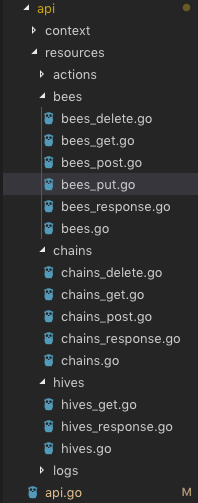beehive 原始碼閱讀- go 語言的自動化機器
Overview
看一下作者本人的註釋
// Package bees is Beehive's central module system.
beehive 非常有趣的在於各邏輯的解耦設計,這不僅讓本身功能操作簡單,也讓擴充套件變得關注點少了很多,只需要一點學習成本就可以擴充套件自己的 beehive
首先解釋一下 bee hive 中 的概念
bee 代表的是我們常見的 Worker 也就是說,實際的行為是由這些 小蜜蜂執行的。他們就類似於採蜜的工人,採集到了之後統一放回來處理
hive 是蜂房,也就是我們常見的 WorkerPool 不同的是,她更像一個 Facotry ,什麼意思呢?她可以建立專屬的 bee 。在極少的配置下,比如只需要配置上一個 token 即可。就可以生成一隻 bee 專門針對某一種蜜工作了。
chain 又是什麼? chain 就是連結事件與處理的工具,我們認為 bee 採回蜜是一個事件,總不可能採回來啥都不幹吧。針對不同的 蜜 我們就有不同的反應,就有不同的 action
比如某人的 blog 更新了 ,rss bee 接收到了之後飛回來,我們就可以再要求 email bee 把這其中的資訊通過郵件發給我們或者我們想發給的人。
這就需要 chain 來聯絡 event 和 action 了
Landscape
API Register
成組的 API 實現了 Resource 介面註冊到 Container 的路由 Route 中。
幫助理解
在檔案中寫好了 作者 實現的 Handle 的實現來註冊 http 請求

API 只是供呼叫,邏輯重點在 bees 這個包裡的實現。
Bee
首先是有的介面
// BeeInterface is an interface all bees implement.
type BeeInterface interface {
// Name of the bee
Name() string
// Namespace of the bee
Namespace() string
// Description of the bee
Description() string
// SetDescription sets a description
SetDescription(s string)
// Config returns this bees config
Config() BeeConfig
// Options of the bee
Options() BeeOptions
// SetOptions to configure the bee
SetOptions(options BeeOptions)
// ReloadOptions gets called after a bee's options get updated
ReloadOptions(options BeeOptions)
// Activates the bee
Run(eventChannel chan Event)
// Running returns the current state of the bee
IsRunning() bool
// Start the bee
Start()
// Stop the bee
Stop()
LastEvent() time.Time
LogEvent()
LastAction() time.Time
LogAction()
Logln(args ...interface{})
Logf(format string, args ...interface{})
LogErrorf(format string, args ...interface{})
LogFatal(args ...interface{})
SetSigChan(c chan bool)
WaitGroup() *sync.WaitGroup
// Handles an action
Action(action Action) []Placeholder
}
和他的基礎實現
// Bee is the base-struct to be embedded by bee implementations.
type Bee struct {
config BeeConfig
lastEvent time.Time
lastAction time.Time
Running bool
SigChan chan bool
waitGroup *sync.WaitGroup
}
這裡需要注意的是 Run 介面,在 Base-Struct Bee 中該方法 是空的實現,因為 Run 是 Bee 的生命週期開始處,是自動開始的。
WebBee 實現
簡單的看某一個實現即可
// WebBee is a Bee that starts an HTTP server and fires events for incoming
// requests.
type WebBee struct {
bees.Bee
addr string
eventChan chan bees.Event
}
可以很清楚的指導,這個 WebBee 中的 eventChan 正是通知的地方,也就是上文所說的 Chain 的開始處。注意的是由於鬆耦合的設計,任何 Bee 都可以成為 Chain 上的一環,只要它能觸發事件。或者監聽事件。
func (mod *WebBee) Run(cin chan bees.Event)
// Run executes the Bee's event loop.
func (mod *WebBee) Run(cin chan bees.Event) {
mod.eventChan = cin
srv := &http.Server{Addr: mod.addr, Handler: mod}
l, err := net.Listen("tcp", mod.addr)
if err != nil {
mod.LogErrorf("Can't listen on %s", mod.addr)
return
}
defer l.Close()
go func() {
err := srv.Serve(l)
if err != nil {
mod.LogErrorf("Server error: %v", err)
}
// Go 1.8+: srv.Close()
}()
select {
case <-mod.SigChan:
return
}
}
同時 WebBee 也有一個方法 ServeHTTP 來實現 http.Handle 來處理請求。
這裡也就是前文所說的 註冊的那些 API 的部分來源,每一個 bee 自身實現的自動註冊暴露給外界呼叫。
func (mod *WebBee) ServeHTTP(w http.ResponseWriter, req *http.Request)
Event
package:beehive/bees/event.go
剛才講到了 觸發事件 event 的 WebBee 實現,現在我們來看 event 的實現
實際上是通過 這個函式實現的
// handleEvents handles incoming events and executes matching Chains.
func handleEvents() {
for {
event, ok := <-eventsIn
···
bee := GetBee(event.Bee)
(*bee).LogEvent()
···
go func() {
defer func() {
if e := recover(); e != nil {
log.Printf("Fatal chain event: %s %s", e, debug.Stack())
}
}()
execChains(&event)
}()
}
}
省略了 日誌部分。可以看到 handleEvents 通過接受通道里的 event,並檢查 event 中的 Bee 作為 標誌找到對應的 Bee 喚醒。
這裡我們可以看到 最後進入了 Chains 中執行,即上文所說的 Chain 將 Event 和 Action 連結了起來,讓 Bee 之間能夠協作。
chain
package:beehive/bees/chains.go
chain 中實際上是呼叫 Actions 通過下面的 execActions 函式
for _, el := range c.Actions {
action := GetAction(el)
if action == nil {
log.Println("\t\tERROR: Unknown action referenced!")
continue
}
execAction(*action, m)
}
我們來看看 Action 的執行。
Action Exec
package: beehive/bees/actions.go
actions 既可以執行設定中的 options 也可以直接在 執行函式中傳入需要執行的 options
func execAction(action Action, opts map[string]interface{}) bool
Summary
整個執行邏輯是如此了,其他還有一些
- 日誌處理:用於跟蹤 bee 和 hive 的情況
- Config:儲存配置檔案,每一次啟動可以重新放飛以前的 Bee 們
- Signal:beehive 攔截了一些 Signal 的 Kill 等訊號來執行優雅退出,避免了 Config 等的丟失。
- Run Flag:執行的附帶引數,設定 Beehive 整個應用的監聽埠和


